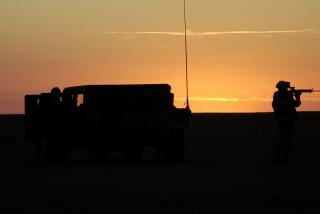Graphic novel as an Afghanistan war primer
- Share via
Reporting from San Diego — — To help prepare Navy medical corpsmen for the stress and danger of Afghanistan deployments, the Navy has turned to a modern form of popular culture: the graphic novel.
Although graphic novels fill several shelves at most large bookstores, their use by the military is relatively new and represents a break from the usual training material that is heavy on the didactic and light on anything that could be labeled as entertainment.
That’s where “The Docs” comes in. It follows four fictional corpsmen as they deploy to Iraq and encounter combat, blood, death, and emotional tumult — elements common to graphic novels. The emphasis is on storytelling and realism, including drawings of Marines and sailors gravely wounded by sniper fire, roadside bombs, and artillery rounds.
The hope among Navy and Marine Corps officials is that the 200-page “The Docs” will be a page-turner for corpsmen; distribution began this month. Many corpsmen are in the 18-to-24-year age group that is accustomed to the genre’s use of furious action, sequential artwork, and themes of good versus evil.
“This is not an instructional manual,” said Greg Goldstein, program manager for Marine Corps Combat & Operational Stress Control. “It’s an easy way to share information: a quick read, relevant, and realistic.”
The idea to develop a graphic novel was borne from studies that showed Navy corpsmen with a high degree of post-deployment psychological strain. In Afghanistan, corpsmen accompany Marine infantry units and Seabee construction units as they venture “outside the wire.” Corpsmen have a dual role of gun-toting combatants and emergency medics.
“Navy corpsmen are very much in the fight,” said Capt. Greg Utz, commanding officer of the San Diego-based Naval Health Research Center. “The numbers show that.” (Forty corpsmen have been killed in the two conflicts).
“The Docs” is meant to prepare first-timers for their deployment to Afghanistan and also to bolster those returning for a second, third or fourth deployment, or possibly remaining stateside and still wrestling with post-combat issues. The language echoes that used by real-life military personnel — the f-word that is ubiquitous in the military is signaled as “f” followed by dashes.
“For purposes of credibility with active-duty personnel, we needed to have the word represented,” said Jerry Larson, chief scientist with the behavioral health section of the Naval Health Research Center, where “The Docs” was developed.
At a cost of $450,000 for development and printing, about 5,000 copies of “The Docs” are being distributed at sites where corpsmen are being trained. Copies are free.
The four corpsmen encounter problems endemic to war-zone deployments: emotional turmoil at leaving families behind, nerve-racking convoys and patrols, suspicion that all locals are their enemy, and, in one instance, fears that a stay-at-home spouse is being unfaithful.
To develop the story lines, the Navy turned to psychologist and former Navy officer Heidi Kraft, whose book “Rule Number Two: Lessons I Learned in a Combat Hospital” details her experiences in Iraq.
(The title comes from an episode of the television show “MASH” in which Hawkeye, a surgeon, says: “In war, rule No. 1 is that young men die. And rule No. 2 is that doctors cannot change rule No. 1.”)
In “The Docs,” when the enemy attacks and Marines are wounded, the corpsmen can save some but not others. One of the corpsmen is reliving the trauma of a previous deployment in which Seabees were killed.
Including a story line of a corpsman being killed and another corpsman struggling emotionally with his death was “one of the most painful decisions” about what to include in the novel, Larson said.
Still, for realism it was seen as a must. “We know that grief is one of the emotional issues that service personnel struggle with,” Larson said.
More to Read
Sign up for our Book Club newsletter
Get the latest news, events and more from the Los Angeles Times Book Club, and help us get L.A. reading and talking.
You may occasionally receive promotional content from the Los Angeles Times.










